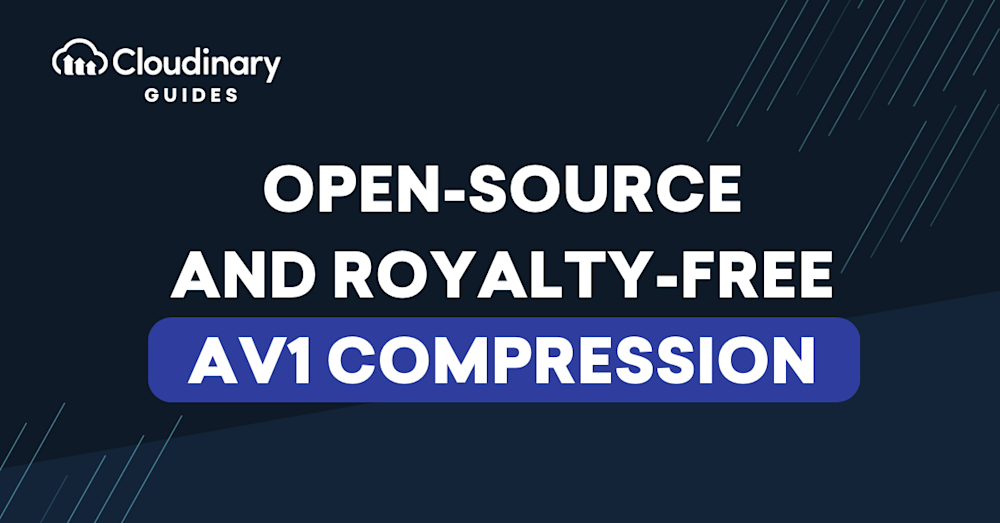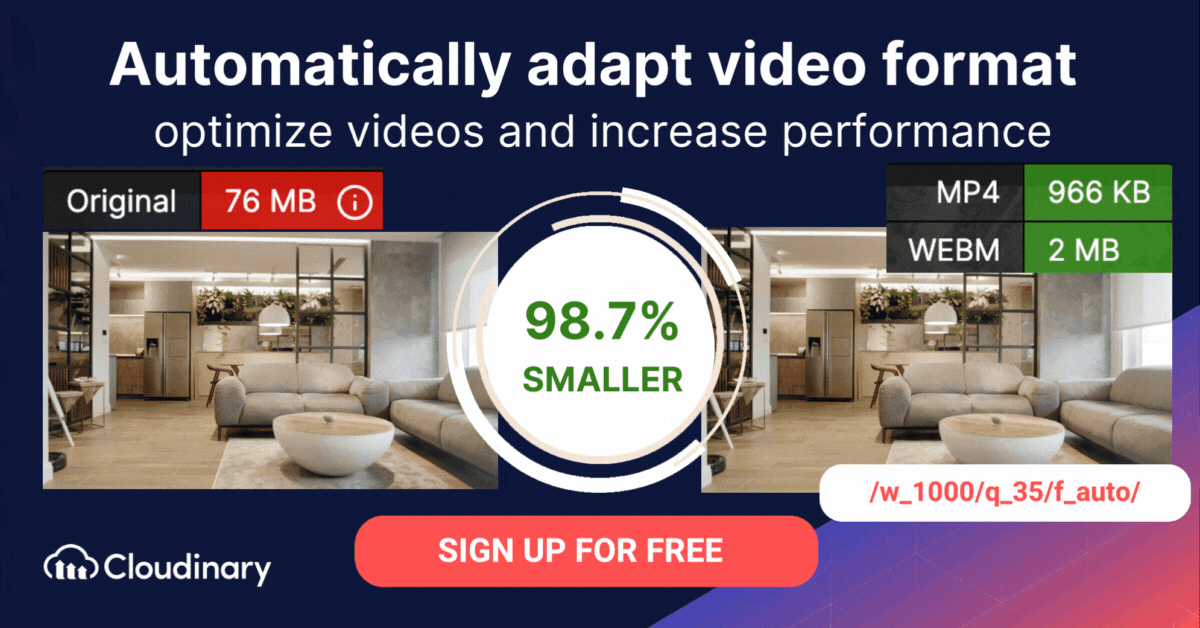
If a picture is worth a thousand words, how many would a video merit?
The past years have seen a massive growth in creation and consumption of video, simultaneously forging content promotion on media networks like YouTube, Vimeo, WhatsApp, LinkedIn, and Instagram. Given that growth, have you considered how video could spruce up your marketing strategy? Not surprisingly, Google favors video, and with YouTube being the second largest search engine after Google, it’s all too obvious why video is instrumental in raising SEO ranking.
However, hosting videos on social networks incurs a load of associated costs. That’s why the AV1 technology has come into play to reduce the streaming bandwidth required for end-users worldwide.
Beyond being a royalty-free codec, AV1 is also fully open-source, allowing developers and organizations to implement and adapt it without licensing restrictions. Its open nature makes it a future-proof solution for high-quality video streaming across devices and platforms.
In this article:
What is the AV1 Codec?
AOMedia Video 1 (AV1) is a royalty-free video coding format specifically designed for internet video transmission. It stands as a successor to VP9, aiming to substantially reduce a video’s bitrate while preserving quality. Unlike many proprietary codecs, AV1 is fully open-source, ensuring widespread accessibility and innovation without licensing costs. This has contributed to its growing adoption across devices and platforms, making it one of the most promising video compression technologies available today. AV1 can provide 30% bandwidth savings compared to its predecessors, like VP9 and HEVC. This efficiency is particularly beneficial in enhancing visual quality at equivalent bitrates, making AV1 a top choice for many content creators and video professionals.
This article chronicles how to compress media files, especially videos, and then optimally deliver them without losing quality.
This is part of a series of articles about video format.
The History of AV1 Codec
The AV1 codec was developed by the Alliance for Open Media, formed by several major tech companies including Amazon, Cisco, Google, Intel, Microsoft, Mozilla, and Netflix. The creation of the AV1 codec was motivated by the high cost and uncertainty associated with the patent licensing of HEVC, a codec designed to succeed AVC. The alliance aimed to deliver high-quality web video and announced the AV1 codec on September 1st 2015.
The AV1 project incorporated components from previous research efforts by Alliance members, such as Xiph’s/Mozilla’s Daala, Google’s VP10, and Cisco’s Thor. The first version of the AV1 reference codec was published in April 2016, and the bitstream specification was released in March of 2018.
The AV1 codec faced several challenges in computational efficiency and speed, with the early version being significantly slower than existing HEVC encoders. However, by March 2019, the speed of the reference encoder had greatly improved. As of January 21, 2021, the MIME type of AV1 was defined as video/AV1.
Since then, AV1 has gained support across a growing number of platforms, operating systems, and media players, further cementing its role as a key video format for the future.
What Are Codecs And Why Are They Necessary?
As software that compresses and decompresses videos, photos, and audio in and out of various formats, codecs contain two components:
- An encoder for compressing files
- A decoder for decompressing files
AV1’s advanced capabilities make it ideal for real-time applications and higher resolutions, including wide color gamuts, higher frame rates, and UHD. Moreover, its potential in streaming HDR 4K video with wide color gamuts is particularly notable.
You should compress videos with a codec before delivering them to users’ devices. Absent codecs, streaming services might never have been possible. For example, not compressing a 4K movie with a codec would mean having to store and stream it in its uncompressed state, which could be a 5-TB file.
Codecs are essential throughout the streaming lifecycle, from shooting and editing to storing and encoding for delivery. In fact, streaming media would be impossible without codecs—at least not for the modern mobile devices. Companies would then have to host and manage larger files; data providers would need to transfer much more data; and end-users must store substantially more material—even if only temporarily.
Many codecs are in use today. Some are free; others (e.g., AVC, aka H.264) require license fees. Here are the popular ones:
- PKZIP: for data
- JPEG, GIF, and PNG: for still images
- MP3 and AAC: for audio
- Cinepak, MPEG-2, H.264, and VP8: for video
It’s useful to distinguish the codec, the software that compresses and decompresses video streams, from the container formats (like .mp4, .mov, or .mkv) that bundle those compressed streams together along with audio, subtitles, and metadata.
A container is simply the “wrapper” that holds one or more codec-encoded streams, whereas the codec itself (AV1, H.264, HEVC, etc.) handles the actual reduction of file size and quality preservation. This separation allows you to mix and match: for example, an AV1-encoded video track can live inside an MKV container just as an H.264 track can live inside MP4.
Encoding means compressing files for efficient editing, storage, and sharing. Decoding enables end-users to open and access content with a suitable application or player, such as VLC media player. For interoperability, encoders and decoders must share a standard format, such as AV1.
AV1 videos can be easily played on various operating systems, including Windows, Linux, and macOS. They can be played by dragging and dropping the AV1 video onto a Chrome tab, using VLC media player, or through YouTube on a desktop, provided you are using a compatible browser.
Because containers wrap codec streams, they play a crucial role in compatibility: a container must be supported by the playback device or application. For example, while most browsers and players handle MP4 containers natively, support for MKV may be more limited (though VLC handles both). When distributing AV1 content broadly, you might choose an MKV container for its flexibility (multiple audio/subtitle tracks, advanced metadata), or MP4 for maximum compatibility on older devices.
For those needing broader compatibility, AV1 videos can also be converted into other widely used formats like MP4 (H.264) using tools like Bandicut, allowing easier playback on older devices and software that might not yet support AV1.

What Are the Metrics of Video Codecs?
Two critical metrics apply to video codecs: bitrate and quality.
According to Android Authority, the higher the bitrate, the larger the encoded files and hence the greater the amount of data end-users must stream. As the bitrate changes, so does the quality, i.e., less data leads to lower fidelity and less accuracy of the source material.
What Is AV1 And What Are Its Characteristics?
Comparable to other video-streaming technologies with patents that cost a hefty fee to use, AV1 is an open-source and royalty-free video codec developed by the nonprofit Alliance for Open Media, which promotes media codecs, formats, and technologies for the web. Because it’s free, AV1 might be the future for streaming platforms like Netflix, Google, etc.
However, it is important to note that AV1 requires more computational resources for encoding and decoding compared to some other codecs, which might be a consideration for certain applications.
Despite these computational demands, AV1 is seeing rapid adoption across mobile and desktop environments. Major streaming platforms and device manufacturers are increasingly supporting AV1 playback, making it a versatile choice for a broad range of video applications.
Also, AV1 operates on the server side and works better at a lower bitrate. Regardless of the type of Android device, AV1 saves data with up to 20% efficiency, transmitting high-quality video online even where bandwidth is constrained.
Pro Tip
Consider Cloudinary’s Video API for Dynamic Video Transcoding
A complete solution to manage, encode, and optimize for any device, channel or network condition. Support for latest codecs (HEVC, VP9, AV1).
-> Learn More About Cloudinary’s Video API
What Are the Other Common Video-Streaming Technologies?
Below are three other common video-streaming technologies, all of which are laden with royalty claims and patents:
- Moving Picture Experts Group (MPEG-2): for DVDs, satellite TV, digital broadcast TV, etc.
- AVC, also called H.264: for Blu-ray discs and many internet-streaming services.
- HEVC, also called H.265: for 8K TV.
How About a Few Further References?
For more details on AV1, visit the AOMediaCodec Community wiki. In addition, read these articles:


